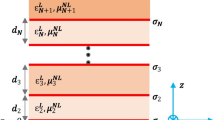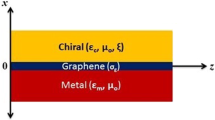Abstract
Graphene has garnered significant interest since its discovery. In graphene, surface plasmon polaritons (SPPs) are excited at frequencies ranging from mid-infrared to terahertz, which is not possible with traditional plasmonic materials. In this manuscript, numerical analysis of SPPs at uniaxial chiral-graphene planar structure is delineated. The surface conductivity of monolayer graphene is modeled by Kubo formulism. The dispersion relation is obtained analytically by applying impedance boundary conditions on the tangential field components. Extended electromagnetic theory is utilized to solve the analytical problem. The variation in effective mode index under the different values of chirality and graphene features (chemical potential, relaxation time, and number of layers) for three types of uniaxial chiral media, i.e., \({\varepsilon }_{t}\) > 0,\({\varepsilon }_{z}\)> 0, \({\varepsilon }_{t}\) < 0, \({\varepsilon }_{z}\) < 0 and \({\varepsilon }_{t}\) > 0, \({\varepsilon }_{z}\) < 0 are analyzed in the THz frequency regime. It is found that the effective mode index is very sensitive when both longitudinal and transverse components of permittivity exhibit opposite signs as compared to other two cases. To confirm the presence of SPPs for the suggested structure, the normalized field distribution for uniaxial chiral medium is also studied. The present work holds promising potential for the fabrication of high-density nanophotonic chips at THz frequency regime.





Similar content being viewed by others
Availability of Data and Materials
Detail about data has been provided in the article.
References
Polo J, Mackay T, Lakhtakia A (2013) Electromagnetic surface waves: a modern perspective. Newnes
Elston SJ, Sambles JR (1990) Surface plasmon-polaritons on an anisotropic substrate
Wang HJOM (1995) Excitation of surface plasmon oscillations at an interface between anisotropic dielectric and metallic media 4(5):651–656
Abdulhalim I (2008) Surface plasmon TE and TM waves at the anisotropic film–metal interface. J Opt A Pure Appl Opt 11(1):015002
Maier SA et al (2003) Local detection of electromagnetic energy transport below the diffraction limit in metal nanoparticle plasmon waveguides 2(4):229–232
Weeber J-C et al (1999) Plasmon polaritons of metallic nanowires for controlling submicron propagation of light 60(12):9061
Oulton RF et al (2008) A hybrid plasmonic waveguide for subwavelength confinement and long-range propagation 2(8):496–500
Bozhevolnyi SI et al (2006) Channel plasmon subwavelength waveguide components including interferometers and ring resonators 440(7083):508–511
Homola J (2003) Present and future of surface plasmon resonance biosensors. Anal Bioanal Chem 377:528–539
Nemova G, Kashyap R (2006) Fiber-Bragg-grating-assisted surface plasmon-polariton sensor. Opt Lett 31(14):2118–2120
Tripathi SM et al (2008) Side-polished optical fiber grating-based refractive index sensors utilizing the pure surface plasmon polariton 26(13):1980–1985
Usbeck K et al (1998) Distributed optochemical sensor network using evanescent field interaction in fibre Bragg gratings. InEuropean Workshop on Optical Fibre Sensors. SPIE
Mansuripur M et al (2009) Plasmonic nano-structures for optical data storage 17(16):14001–14014
Shi J et al (2021) Nonlinear nanophotonics based on surface plasmon polaritons 119(13):130501
Gordon R (2008) Surface plasmon nanophotonics: a tutorial. IEEE Nanotechnol Mag 2(3):12–18.
Luo X, Yan L (2012) Surface plasmon polaritons and its applications. IEEE Photonics J 4(2):590–595
Yokogawa S, Burgos SP, Atwater HA (2012) Plasmonic color filters for CMOS image sensor applications. Nano lett 12(8):4349–4354
Ashino M, Ohtsu M (1998) Fabrication and evaluation of a localized plasmon resonance probe for near-field optical microscopy/spectroscopy. Appl Phys Lett 72(11):1299–1301
Lin W et al (2018) Propagating surface plasmon polaritons for remote excitation surface-enhanced Raman scattering spectroscopy 53(10):771–782
Zhang J, Zhang L, Xu W (2012) Surface plasmon polaritons: physics and applications. J Phys D Appl Phys 45(11):113001
Kawata S, Ohtsu M, Irie M (2001) Near-field optics and surface plasmon polaritons. Springer Science & Business Media 81
Cui TJ, Shen X (2013) THz and microwave surface plasmon polaritons on ultrathin corrugated metallic strips. IEEE Trans Terahertz Sci Technol 6(2):147–164
Gric T, Rafailov EJO (2022) Propagation of surface plasmon polaritons at the interface of metal-free metamaterial with anisotropic semiconductor inclusions 254:168678
Ioannidis T, Gric T, Rafailov EJP (2021) Looking into surface plasmon polaritons guided by the acoustic metamaterials 16:1835–1839
Gric T, Hess O (2017) Tunable surface waves at the interface separating different graphene-dielectric composite hyperbolic metamaterials. Opt Express 25(10):11466–11476.
Gric T (2016) Surface-plasmon-polaritons at the interface of nanostructured metamaterials. Prog Electromagn Res M 46:165–172
Gric T, Rafailov EJO, Electronics Q (2020) A systematic insight into the surface plasmon polaritons guided by the graphene based heterostructures 52(9):404
Wang X, Shi G (2015) An introduction to the chemistry of graphene. Phys Chem Chem Phys 17(43):28484–28504
Liu S et al (2014) Coherent and tunable terahertz radiation from graphene surface plasmon polaritons excited by an electron beam 104(20):201104
Engheta N, Jaggard DL (1998) Electromagnetic chirality and its applications. IEEE Antennas and Propagation Society Newsletter 30(5):6–12
Jaggard DL, Mickelson AR, Papas CH (1979) On electromagnetic waves in chiral media. Appl Phys 18: 211–216
Faryad M (2019) Surface plasmon-polariton waves guided by reciprocal, uniaxially chiral, bianisotropic material. in Plasmonics: Design, Materials, Fabrication, Characterization, and Applications XVII. SPIE
Ghaffar A et al (2014) Radiation properties of a uniaxial chiral quadratic inhomogeneous slab under oblique incidence 125(4):1589–1597
Ghaffar A, Alkanhal MA (2014) Electromagnetic waves in parallel plate uniaxial anisotropic chiral waveguides. Opt Mater Express 4(9):1756–1761
Yaqoob MZ (2019) Characteristics of light–plasmon coupling on chiral–graphene interface. JOSA B 36(1):90–95
Vakil A, Engheta NJS (2011) Transformation optics using graphene 332(6035):1291–1294
Idzuchi H, Fert A, Otani Y (2015) Revisiting the measurement of the spin relaxation time in graphene-based devices. Phys Rev B 91(24):241407
Hanson GW (2008) Quasi-transverse electromagnetic modes supported by a graphene parallel-plate waveguide. J Appl Phys 104(8).
Gao Y et al (2014) Analytical model for plasmon modes in graphene-coated nanowire 22(20):24322–24331
Kim KK et al (2010) Enhancing the conductivity of transparent graphene films via doping 21(28):285205
Toqeer I et al (2019) Characteristics of dispersion modes supported by graphene chiral graphene waveguide 186:28–33
Yaqoob MZ et al (2019) Analysis of hybrid surface wave propagation supported by chiral metamaterial–graphene–metamaterial structures. Results Phys 14:102378
Yaqoob MZ et al (2018) Hybrid surface plasmon polariton wave generation and modulation by chiral-graphene-metal (CGM) structure. Sci Rep 8(1):18029
Azam M et al (2021) Dispersion characteristics of surface plasmon polaritons (SPPs) in graphene–chiral–graphene waveguide. Waves in Random and Complex Media 1–12.
Acknowledgements
The authors would like to thank the Higher Education Commission of Pakistan for the funding through HEC Indigenous Ph.D. Fellowship Program.
Funding
Higher Education Commission of Pakistan,through HEC Indigenous Ph.D. Fellowship Program
Author information
Authors and Affiliations
Contributions
MA wrote the main manuscript and derived analytical expressions. AG edited the manuscript and reviewed the numerical analysis. MYN and HNB developed methodology in the given study. Author MA was also encouraged and completely supervised during the preparation of the manuscript by AG. All authors reviewed the manuscript before submission.
Corresponding author
Ethics declarations
Ethical Approval
Not applicable
Additional information
Publisher's Note
Springer Nature remains neutral with regard to jurisdictional claims in published maps and institutional affiliations.
Rights and permissions
Springer Nature or its licensor (e.g. a society or other partner) holds exclusive rights to this article under a publishing agreement with the author(s) or other rightsholder(s); author self-archiving of the accepted manuscript version of this article is solely governed by the terms of such publishing agreement and applicable law.
About this article
Cite this article
Arif, M., Ghaffar, A., Naz, M.Y. et al. Excitation of Surface Plasmon Polaritons (SPPs) at Uniaxial Chiral-Graphene Planar Structure. Plasmonics (2024). https://doi.org/10.1007/s11468-023-02168-2
Received:
Accepted:
Published:
DOI: https://doi.org/10.1007/s11468-023-02168-2




